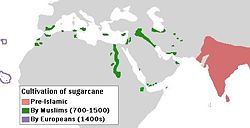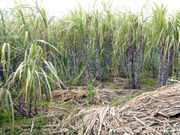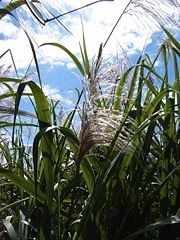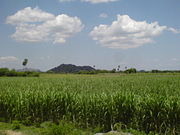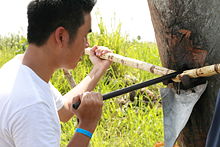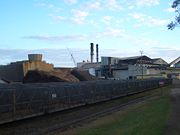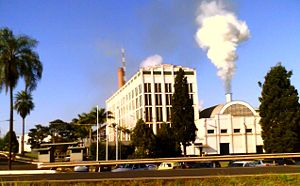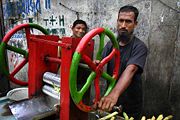Sugarcane
2008/9 Schools Wikipedia Selection. Related subjects: Agriculture; Plants
| Sugarcane | ||||||||||||
|---|---|---|---|---|---|---|---|---|---|---|---|---|
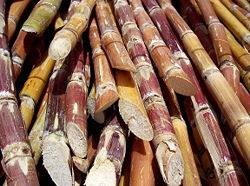 Cut sugarcane
|
||||||||||||
| Scientific classification | ||||||||||||
|
||||||||||||
| Species | ||||||||||||
|
Saccharum arundinaceum |
Sugarcane or sugar cane (Saccharum) is a genus of 6 to 37 species (depending on taxonomic interpretation) of tall perennial grasses (family Poaceae, tribe Andropogoneae), native to warm temperate to tropical regions of the Old World. They have stout, jointed, fibrous stalks that are rich in sugar and measure 2 to 6 meters tall. All of the sugarcane species interbreed, and the major commercial cultivars are complex hybrids.
Cultivation and uses
About 200 countries grow the crop to produce 1,324.6 million tons (more than six times the amount of sugar beet produced). As of the year 2005, the world's largest producer of sugar cane by far is Brazil followed by India. Uses of sugar cane include the production of sugar, Falernum, molasses, rum, soda, cachaça (the national spirit of Brazil) and ethanol for fuel. The bagasse that remains after sugarcane crushing may be burned to provide both heat - used in the mill, and electricity - typically sold to the consumer electricity grid. It may also, because of its high cellulose content, be used as raw material for paper and cardboard, branded as " environmentally friendly" as it is made from a by-product of sugar production.
Fibre from Bengal Cane (Saccharum munja or Saccharum bengalense) is also used to make mats, screens or baskets etc. in West Bengal. This fibre is also used in Upanayanam - a rite-of-passage ritual in India and therefore is also significant religiously.
History
Sugarcane was originally from tropical South Asia and Southeast Asia. Different species likely originated in different locations with S. barberi originating in India and S. edule and S. officinarum coming from New Guinea. The thick stalk stores energy as sucrose in the sap. From this juice, sugar is extracted by evaporating the water. Crystallized sugar was reported 5000 years ago in India.
Legend has it that Alexander the Great was surprised to find the sweet substance different from honey during his campaign in North India. Around the eighth century A.D., Arabs introduced sugar to the Mediterranean, Mesopotamia, Egypt, North Africa, and Spain. By the tenth century, sources state, there was no village in Mesopotamia that didn't grow sugar cane. It was among the early crops brought to the Americas by Spaniards. Brazil is currently the biggest sugar cane producing country.
The methods of growing sugarcane and processing sugar were technologies transferred to China from India in the 7th century, during the reign of Harsha (r. 606–647) over North India and the reign of Emperor Taizong (r. 626–649) over Tang China. Two sugar makers summoned from leaders of Mahabodhi Temple traveled alongside a delegation of Buddhist monks to China, where they successfully taught the Chinese how to grow sugarcane and produce sugar.
A boiling house was used in the 17th through 19th centuries to make sugarcane juice into raw sugar. These houses were add-ons to the sugar plantations in the western colonies. This process was often conducted by the African slaves, under very poor conditions. The boiling house was made of cut stone. The furnaces were rectangular boxes of brick or stone with openings near to one side, and at the bottom to stoke the fire and pull out the ashes. At the top of each furnace were up to seven copper kettles or boilers, each one smaller than the previous one and hotter. The cane juice was placed in the first copper kettle which was the largest. The juice was then heated and a little lime added to remove impurities. The juice was then skimmed then channeled to the other copper kettles. The last kettle,which was called the 'teache' was where the cane juice became syrup. It was then put into cooling troughs where the sugar crystals hardened around a sticky core of molasses. The raw sugar was then shoveled from the cooling trough into hogsheads (wooden barrels) where they were put in the curing house.
Sugarcane was, and still is, extensively grown in the Caribbean, where it was first brought by Christopher Columbus during his second voyage to The Americas, initially to the island of Hispaniola (Modern day Haiti And the Dominican Republic) . In colonial times, sugar was a major product of the triangular trade of New World raw materials, European manufactures, and African slaves. France found its sugarcane islands so valuable it effectively traded its portion of Canada, famously dubbed " a few acres of snow," to Britain for their return of Guadeloupe, Martinique and St. Lucia at the end of the Seven Years' War. The Dutch similarly kept Suriname, a sugar colony in South America, instead of seeking the return of the New Netherlands (New Amsterdam). Cuban sugarcane produced sugar that received price supports from and a guaranteed market in the USSR; the dissolution of that country forced the closure of most of Cuba's sugar industry. Sugarcane remains an important part of the economy of Belize, Barbados, Haiti along with the Dominican Republic, Guadeloupe, Jamaica, and other islands. The sugarcane industry is a major export for the Caribbean, but it is expected to collapse with the removal of European preferences by 2009.
Sugarcane production greatly influenced many tropical Pacific islands, including Okinawa and most particularly Hawaii and Fiji. In these islands, sugar cane came to dominate the economic and political landscape after the arrival of powerful European and American agricultural business, which promoted immigration from various Asian countries for workers to tend and harvest the crop. Sugar-industry policies eventually established the ethnic makeup of the island populations that now exist, profoundly affecting modern politics and society in the islands.
Brazil is a major grower of sugarcane, which is used to produce sugar and provide the ethanol used in making gasoline-ethanol blends ( gasohol) for transportation fuel. In India, sugarcane is sold as jaggery and also refined into sugar, primarily for consumption in tea and sweets, and for the production of alcoholic beverages.
Cultivation
Sugarcane cultivation requires a tropical or subtropical climate, with a minimum of 600 mm (24 in) of annual moisture. It is one of the most efficient photosynthesizers in the plant kingdom, able to convert up to 2 percent of incident solar energy into biomass. In prime growing regions, such as Peru, Brazil, Colombia, Australia, Ecuador, Cuba and Hawaii, sugarcane can produce 20 kg for each square meter exposed to the sun.
Sugarcane is propagated from cuttings, rather than from seeds; although certain types still produce seeds, modern methods of stem cuttings have become the most common method of reproduction. Each cutting must contain at least one bud, and the cuttings are usually planted by hand. Once planted, a stand of cane can be harvested several times; after each harvest, the cane sends up new stalks, called ratoons. Usually, each successive harvest gives a smaller yield, and eventually the declining yields justify replanting. Depending on agricultural practice, two to ten harvests may be possible between plantings.
Sugarcane is harvested mostly by hand or sometimes mechanically. Hand harvesting accounts for more than half of the world's production, and is especially dominant in the developing world. When harvested by hand, the field is first set on fire. The fire spreads rapidly, burning away dry dead leaves, and killing any venomous snakes hiding in the crop, but leaving the water-rich stalks and roots unharmed. With cane knives or machetes, harvesters then cut the standing cane just above the ground. A skilled harvester can cut 500 kg of sugarcane in an hour.
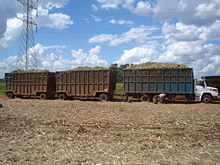
With mechanical harvesting, a sugarcane combine (or chopper harvester), a harvesting machine originally developed in Australia, is used. The Austoft 7000 series was the original design for the modern harvester and has now been copied by other companies including Cameco and John Deere. The machine cuts the cane at the base of the stalk, separates the cane from its leaves, and deposits the cane into a haulout transporter while blowing the trash back onto the field. Such machines can harvest 100 tonnes of cane each hour, but cane harvested using these machines must be transported to the processing plant rapidly; once cut, sugarcane begins to lose its sugar content, and damage inflicted on the cane during mechanical harvesting accelerates this decay.
Sugar cane is cultivated in almost all the world only for some months of the year, in a period called 'safra', the Portuguese word for harvest. The only place in the world where there is no 'safra', and therefore sugar cane is cultivated and produced year round is Colombia in South America.
Pests
The most important sugarcane pests are the larvae of some butterfly/moth species, including the turnip moth, the sugarcane borer (Diatraea saccharalis), the Mexican rice borer (Eoreuma loftini), leaf-cutting ants, termites; spittlebugs (especially Mahanarva fimbriolata and Deois flavopicta), and the beetle Migdolus fryanus. The planthopper Eumetopina flavipes is an insect which acts as a vector for the phytoplasma which causes the sugarcane disease ramu stunt.
Diseases
Processing
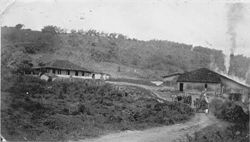
Traditionally, sugarcane has been processed in two stages. Sugarcane mills, located in sugarcane-producing regions, extract sugar from freshly harvested sugarcane, resulting in raw sugar for later refining, and in "mill white" sugar for local consumption. Sugar refineries, often located in heavy sugar-consuming regions, such as North America, Europe, and Japan, then purify raw sugar to produce refined white sugar, a product that is more than 99 percent pure sucrose. These two stages are slowly becoming blurred. Increasing affluence in the sugar-producing tropics has led to an increase in demand for refined sugar products in those areas, where a trend toward combined milling and refining has developed.
Milling
Sugarcane first has to be moved to a mill which is usually located close to the area of cultivation. Small rail networks are a common method of transporting the cane to a mill.
In a sugar mill, sugarcane is washed, chopped, and shredded by revolving knives. The shredded cane is repeatedly mixed with water and crushed between rollers; the collected juices (called garapa in Brazil) contain 10–15 percent sucrose, and the remaining fibrous solids, called bagasse, are burned for fuel. Bagasse makes a sugar mill more than self-sufficient in energy; the surplus bagasse can be used for animal feed, in paper manufacture, or burned to generate electricity for the local power grid.
The cane juice is next mixed with lime to adjust its pH to 7. This mixing arrests sucrose's decay into glucose and fructose, and precipitates out some impurities. The mixture then sits, allowing the lime and other suspended solids to settle out, and the clarified juice is concentrated in a multiple-effect evaporator to make a syrup about 60 percent by weight in sucrose. This syrup is further concentrated under vacuum until it becomes supersaturated, and then seeded with crystalline sugar. Upon cooling, sugar crystallizes out of the syrup. A centrifuge is used to separate the sugar from the remaining liquid, or molasses. Additional crystallizations may be performed to extract more sugar from the molasses; the molasses remaining after no more sugar can be extracted from it in a cost-effective fashion is called blackstrap.
Raw sugar has a yellow to brown colour. If a white product is desired, sulfur dioxide may be bubbled through the cane juice before evaporation; this chemical bleaches many colour-forming impurities into colourless ones. Sugar bleached white by this sulfitation process is called "mill white," "plantation white," and "crystal sugar." This form of sugar is the form most commonly consumed in sugarcane-producing countries.
Refining
In sugar refining, raw sugar is further purified. It is first mixed with heavy syrup and then centrifuged clean. This process is called 'affination'; its purpose is to wash away the outer coating of the raw sugar crystals, which is less pure than the crystal interior. The remaining sugar is then dissolved to make a syrup, about 70 percent by weight solids.
The sugar solution is clarified by the addition of phosphoric acid and calcium hydroxide, which combine to precipitate calcium phosphate. The calcium phosphate particles entrap some impurities and absorb others, and then float to the top of the tank, where they can be skimmed off. An alternative to this "phosphatation" technique is ' carbonatation,' which is similar, but uses carbon dioxide and calcium hydroxide to produce a calcium carbonate precipitate.
After any remaining solids are filtered out, the clarified syrup is decolorized by filtration through a bed of activated carbon; bone char was traditionally used in this role, but its use is no longer common. Some remaining colour-forming impurities adsorb to the carbon bed. The purified syrup is then concentrated to supersaturation and repeatedly crystallized under vacuum, to produce white refined sugar. As in a sugar mill, the sugar crystals are separated from the molasses by centrifuging. Additional sugar is recovered by blending the remaining syrup with the washings from affination and again crystallizing to produce brown sugar. When no more sugar can be economically recovered, the final molasses still contains 20–30 percent sucrose and 15–25 percent glucose and fructose.
To produce granulated sugar, in which the individual sugar grains do not clump together, sugar must be dried. Drying is accomplished first by drying the sugar in a hot rotary dryer, and then by conditioning the sugar by blowing cool air through it for several days.
Ribbon cane syrup
Ribbon cane is a subtropical type that was once widely grown in southern United States, as far north as coastal North Carolina. The juice was extracted with horse or mule-powered crushers; the juice was boiled, like maple syrup, in a flat pan, and then used in the syrup to form as a sweetener for other foods. It is not a commercial crop nowadays, but a few growers try to keep alive the old traditions and find ready sales for their product. Most sugarcane production in the United States occurs in Florida and Louisiana, and to a lesser extent in Hawaii and Texas.
Production
| Country | 1000 tons |
|---|---|
| 588,025 (2008) | |
| 232,300 | |
| 87,768 | |
| 47,244 | |
| 45,195 | |
| 43,665 | |
| 39,849 | |
| 37,822 | |
| 29,505 | |
| 25,307 | |
| World Total | 1,011,581 |
| Source: UN Food & Agriculture Organisation (FAO) |
|
In India, the states of Uttar Pradesh (38.57 %), Maharashtra (17.76 %) and Karnataka (12.20 %) lead the nation in sugarcane production.
In the United States, sugar cane is grown commercially in Florida, Hawaii, Louisiana, Texas, and Puerto Rico.
Cane ethanol / Energy cane
This is generally available as a by-product of sugar mills producing sugar. It can be used as a fuel, mainly as a biofuel alternative to gasoline, and is widely used in cars in Brazil. It is steadily becoming a promising alternative to gasoline throughout much of the world and thus instead of sugar may be produced as a primary product out of sugar canes processing.
A textbook on renewable energy describes the energy transformation:
At present, 75 tons of raw sugar cane are produced annually per hectare in Brazil. The cane delivered to the processing plant is called burned and cropped (b&c) and represents 77% of the mass of the raw cane. The reason for this reduction is that the stalks are separated from the leaves (which are burned and whose ashes are left in the field as fertilizer) and from the roots that remain in the ground to sprout for the next crop. Average cane production is, therefore, 58 tons of b&c per hectare per year.
Each ton of b&c yields 740 kg of juice (135 kg of sucrose and 605 kg of water) and 260 kg of moist bagasse (130 kg of dry bagasse). Since the higher heating value of sucrose is 16.5 M J/kg, and that of the bagasse is 19.2 M J/kg, the total heating value of a ton of b&c is 4.7 G J/kg of which 2.2 G J come from the sucrose and 2.5 from the bagasse.
Per hectare per year, the biomass produced corresponds to 0.27 T J. This is equivalent to 0.86 W per square meter. Assuming an average insolation of 225 W per square meter, the photosynthetic efficiency of sugar cane is 0.38%.
The 135 kg of sucrose found in 1 ton of b&c are transformed into 70 liters of ethanol with a combustion energy of 1.7 G J. The practical sucrose-ethanol conversion efficiency is, therefore, 76% (compare with the theoretical 97%).
One hectare of sugar cane yields 4000 liters of ethanol per year (without any additional energy input because the bagasse produced exceeds the amount needed to distill the final product). This however does not include the energy used in tilling, transportation, and so on. Thus, the solar energy-to-ethanol conversion efficiency is 0.13%.
Sugarcane as food
In most countries where sugarcane is cultivated, there are several foods and popular dishes derived from it, such as:
- Direct consumption of raw sugarcane cylinders or cubes, which are chewed to extract the juice, and the bagasse is spat out
- Freshly extracted juice ( garapa, guarab, guarapa, guarapo, papelón, 'aseer asab or caldo de cana) by hand or electrically operated small mills, with a touch of lemon and ice, makes a delicious and popular drink.
- Molasses, used as a sweetener and as a syrup accompanying other foods, such as cheese or cookies
- Rapadura, a candy made of flavored solid brown sugar in Brazil, which can be consumed in small hard blocks, or in pulverized form (flour), as an add-on to other desserts.
- Sugarcane is also used in rum production, especially in the Caribbean.
- Cane sugar syrup was the traditional sweetener in soft drinks for many years, but has been largely supplanted (in the US at least) by high-fructose corn syrup, which is less expensive, but is considered by some to not taste quite like the sugar it replaces.
